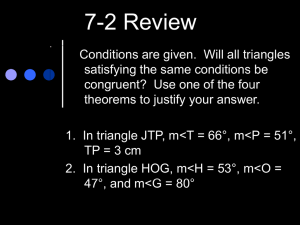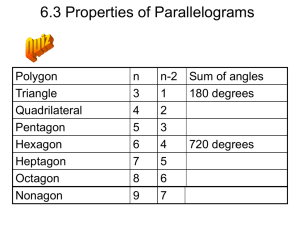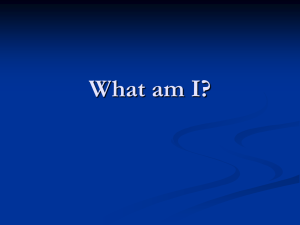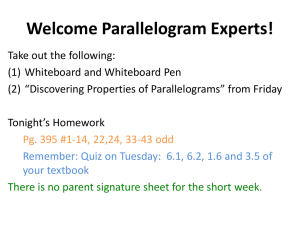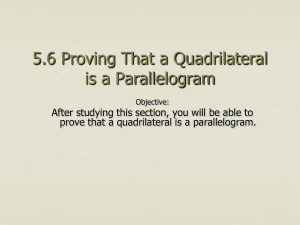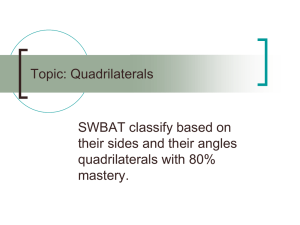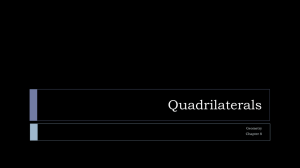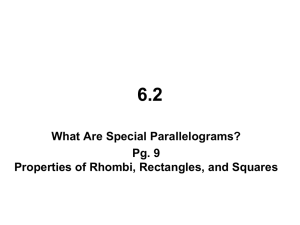Conditions of Parallelograms (6.3) and Special Parallelograms (6.4)
advertisement
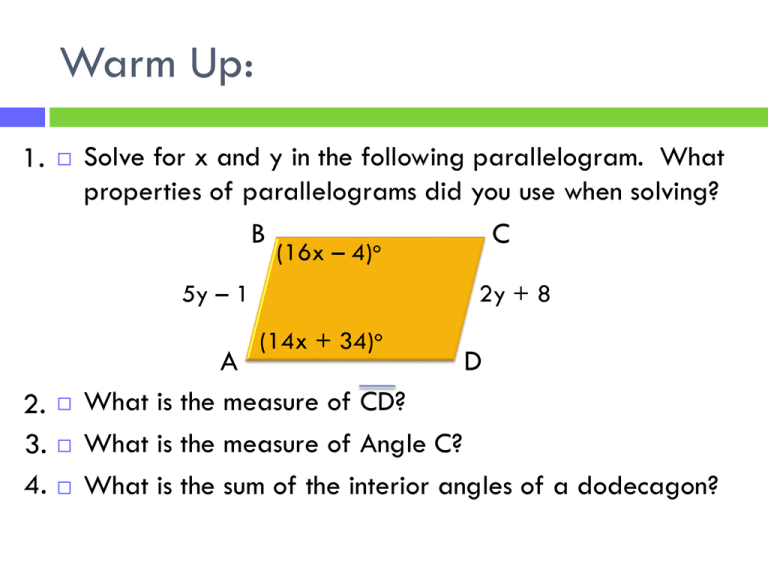
Warm Up: 1. Solve for x and y in the following parallelogram. What properties of parallelograms did you use when solving? B C o (16x – 4) 5y – 1 2y + 8 (14x + 34)o 2. 3. 4. A D What is the measure of CD? What is the measure of Angle C? What is the sum of the interior angles of a dodecagon? Conditions of Parallelograms (6.3) and Special Parallelograms (6.4) IF a quadrilateral is a parallelogram, THEN its opposite sides are congruent. Conditions of Parallelograms (6.3) and Special Parallelograms (6.4) IF a quadrilateral is a parallelogram, THEN its opposite sides are congruent. IF both pairs of opposite sides of a quadrilateral are congruent, THEN the quadrilateral is a parallelogram. Conditions of Parallelograms (6.3) and Special Parallelograms (6.4) IF a quadrilateral is a parallelogram, THEN its opposite angles are congruent. Conditions of Parallelograms (6.3) and Special Parallelograms (6.4) IF a quadrilateral is a parallelogram, THEN its opposite angles are congruent. IF both pairs of opposite angles of a quadrilateral are congruent, THEN the quadrilateral is a parallelogram. Conditions of Parallelograms (6.3) and Special Parallelograms (6.4) IF a quadrilateral is a parallelogram, THEN its consecutive angles are supplementary. B C o o (180 – x) A xo x (180 – x)o D Conditions of Parallelograms (6.3) and Special Parallelograms (6.4) IF a quadrilateral is a parallelogram, THEN its consecutive angles are supplementary. B C o o (180 – x) xo x (180 – x)o A D IF an angle of a quadrilateral is supplementary to both of its consecutive angles, THEN the quadrilateral is a parallelogram. Conditions of Parallelograms (6.3) and Special Parallelograms (6.4) IF a quadrilateral is a parallelogram, THEN its diagonals bisect each other. Conditions of Parallelograms (6.3) and Special Parallelograms (6.4) IF a quadrilateral is a parallelogram, THEN its diagonals bisect each other. IF the diagonals of a quadrilateral bisect each other, THEN the quadrilateral is a parallelogram. Conditions of Parallelograms (6.3) and Special Parallelograms (6.4) IF one pair of opposite sides of a quadrilateral are parallel AND congruent, THEN the quadrilateral is a parallelogram. Show that ABCD is a parallelogram for m = 12 and n = 9.5; which one of the conditions of parallelograms did you use? B A (2m + 31)o (7m – 29)o (12n + 11)o D C Are each of the given quadrilaterals also parallelograms? Justify your answer. #1 #2 #3 7 7 Find x and y so the quadrilateral is a parallelogram. (x – 12)o B A (3y – 4)o (4x – 8)o D (1/2 y)o C RECTANGLES RECTANGLE Four Right Angles Congruent Diagonals Properties of a Parallelogram RHOMBUSES RHOMBUS Four Congruent Sides Perpendicular Diagonals Diagonals Bisect Opposite Angles Properties of a Parallelogram SQUARES SQUARE Properties of a Rectangle Properties of a Rhombus ABCD is a rhombus. Find the measure of Angle B. (y + 2)o B C (2y + 10)o A D Show the diagonals of square ABCD are congruent perpendicular bisectors of each other. A (-1, 0) B (-3, 5) C (2, 7) D (4, 2)
